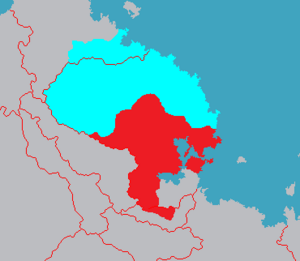Northern and Southern Dynasties (Quenmin)
Part of a series on the |
|---|
| History of Quenmin |
 |
The Northern and Southern Dynasties Era, or more aptly named the Northern and Southern Dynasties (Quenminese: Các triều đại phía Bắc và Nam), was a historical period in Quenmin that occurred during the middle and late 14th century. Lasting from 1369 to 1423, it was an era where two rivaling dynasties emerged and fought for legitimacy of rule over the nation after the demise of the Later Nguyễn Dynasty. In the north lies the Bắc Rịa Dynasty, controlled by the alliance of the Trịnh and Mạc families, and in the south the Sông Cầu Dynasty, ruled by the Thiện, Phạm and Mông families.
The decadent rule of the Later Nguyễn Dynasty gave rise to political upheavals that tore the empire apart. During the mid-14th century, the rule of the Later Nguyễn Dynasty was degenerating from inept leadership with last three emperors, paving the way for rampant corruption and internal strife to occur. Nguyễn Chiến Tông had initiated land and tax reforms that catalyzed the decline of the Dynasty's power. Subsequently, Nguyễn Nghi Tông inherited his rule and began to crack down on those who opposed the dynastic laws, further fueling the turmoil. Finally, the inept and stagnating rule of Nguyễn Nông Tông ended the dynasty's right to rule with Trịnh Hiến and Mạc Kiến Bình ousting him from the throne.
The fall of the Dynasty gave way for two prominent Dynasties in the northern and southern parts of Quenmin's current territory.
Background
Sông Cầu Dynasty
Formation
Seeing this decadence unfold under the rule of Nguyễn Chiến Tông, various noble and aristocratic families residing in the southern territories sought the opportunity to covet more political power for themselves. Moreover, three of these families Thiện, Phạm and Mông would play a huge role in this time of disharmony.
Uprising by the Thiện Family
Contributing to the formation of the Dynasty was the revolt initiated by the Thiện family, of whom rules the County of Buôn Tho. What lead to this was the land reforms initiated by Nguyễn Chiến Tông.
Bắc Rịa Dynasty
Deposition of Nguyễn Nông Tông
During the reign of Nguyễn Nông Tông, Trịnh Hiến, the son of Lord Trịnh Phong, was a prominent scholar-official who became an advisor to the Emperor. Nguyễn Nông Tông was known to be a lazy and flamboyant monarch, where he lets his subordinate staff take care of political and economic matters, while spending the royal treasury on leisurely activities and exuberant parties, and indulging in sexual activities with his concubines and various prostitutes. Cognizant of how his rule is plunging the empire into further decline and there would be nothing to stop it, Hiến sought the assistance of Mạc Kiến Bình, the the current patriarch of the Mạc family and the incumbent Governor of Toản Lộc who also holds a seat in the Imperial Court. On the evening of June 15, 1369, Hiến discussed his plan to depose the emperor, to which Bình agreed.
In securing support from generals and other disgruntled aristocratic families, Hiến had the Imperial Palace stormed on June 27 with 200 men. When hearing of the news that the Palace had been taken, Hiến and Bình went into the bedroom that Nông Tông has locked himself in. Hiến ordered that the Emperor be taken into the courtyard and executed by decapitation.
